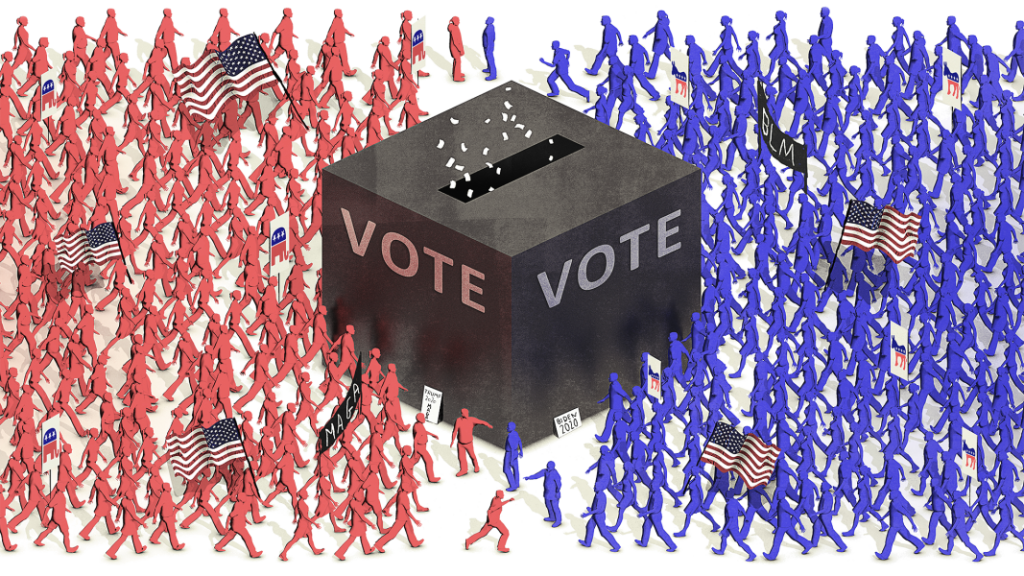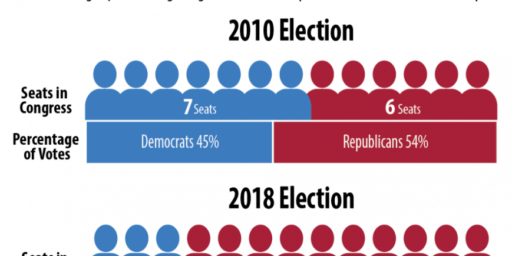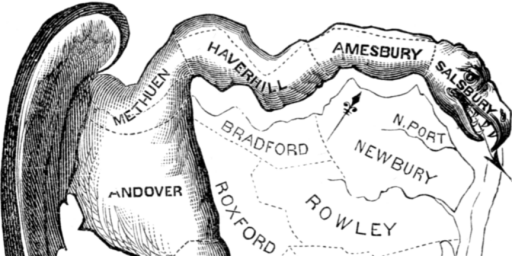Republicans Winning House Popular Vote?
A surprising factoid in a bad election for the party.

Interesting Twitter thread from Sean Trende of RealClearPolitics. I’m taking the liberty of turning it into paragraphs for the sake of ease of reading here:
One of the quiet stories under the hood is that Republicans are looking like they’ll win the popular vote. Probably a popular vote swing of 5% (depending on how CA votes work out), swinging about 2% of the chamber. IOW, the generic polls are likely to be about spot on. Why?
An easy story is uncontested seats; there were about 8 more GOP uncontested than Democrats. But in some of those, they don’t count any votes, so it net hurts the GOP. And there are seats where two Democrats ran against each other, so Ds double dip.
CA has a lot of votes left to count, but I’m building that into my estimate. Rs are up six in the generic ballot right now; a 5 point swing would have them win by two. CA had a gap of 4 million in the popular vote, and it looks like about half the ballots are counted already.
And some states, like AZ, will see final counts that are helpful. So what explains it? Some of it is the chart that I talked about again and again this cycle. At R+2, the popular vote is still nestled in the valley where there just aren’t that many seats to flip.
In other words, the “Biden + 10 levy” held. Combine that with some bad candidates in Biden <10 districts (e.g., OH-09) and you get a fuller explanation. But the quiet story under the hood [i]s something @amyewalter and I talked about maybe even last year: Republicans did relatively well with Black and especially Hispanic voters. But it didn’t translate to seats. So Bennie Thompson is at 58% in his minority-majority district in MS [o]r Linda Sanchez at 54% in a 66% Clinton/62% Biden district (though she’ll improve as votes come in).
Anyway, this is just a nice reminder that structural advantages aren’t permanent, and as the GOP vote migrates to rural areas where they’re already strong [o]r minority areas where they’ll do better but not well enough to win, they start to produce some of the inefficiencies that have bedeviled Democrats the past few cycles.
California’s numbers could be way more than Trende is estimating here, so this is premature. But interesting if it bears out or even comes close to doing so. Not because it changes any outcomes or in any way glosses over the fact that Republicans vastly underperformed the fundamentals because they ran awful candidates, too many of whom embraced the Big Lie, but because of Trende’s point about structural advantages.
It has long been noted—Steven Taylor has pointed to it many times here over the years—that Republicans are overrepresented not just in the Senate, which intentionally ignores population, but also in the House, which ostensibly does not. Put simply:
[T]he House retains a rural bias. Republican voters are more efficiently distributed across the country than Democrats, who are concentrated in cities. That means that even when Democrats win 50 percent of voters nationwide, they invariably hold fewer than 50 percent of House seats, regardless of partisan gerrymandering.
Single-member districts mean that a vote cast for a losing candidate will not be represented. Similarly, a vote cast for a candidate over the threshold needed to win is electorally useless. Both of these votes are, to use a harsh term, “wasted votes.” Democrats cast more wasted votes than Republicans due to an imbalance in how party members are distributed among districts. This imbalance is a result of both natural sorting and political gerrymandering.
Natural sorting describes how members of the two parties are distributed across the country. Democrats are heavily concentrated in cities and urban areas; Republicans tend to be scattered among rural, exurban, and suburban districts. There are more districts with very high concentrations of Democratic voters than there are districts with very high concentrations of Republican voters. This Democratic density makes it easy to win individual seats but creates lots of wasted votes. Research by political scientists Jonathan Rodden and Jowei Chen, as well as Rodden’s new book, Why Cities Lose, show that geography and natural sorting are the root of Democrats’ electoral challenges.
Political gerrymandering is the manipulation of electoral districts to favor one party over another. States where one party controls the process often attempt to maximize their party’s representation using tactics called “packing” and “cracking.” Packing is drawing districts to heavily overrepresent the opposition party, wasting as many votes as possible over the winning threshold. Cracking is the opposite: diluting the opposition’s voters into districts so they cannot reach the threshold. Most statewide gerrymanders are a combination of packing and cracking.
Natural sorting and gerrymandering can only distort House representation away from the national popular vote because we use single-member districts. Together, single-member districts, natural sorting, and gerrymandering form the origin of bias in the House.
For a variety of reasons, even though the apportionment following the 2020 Census led to predictions of the creation of multiple new Republican seats, that didn’t happen. Indeed, had New York’s state supreme court not overturned a Democratic gerrymander, the opposite would have happened.
But it’s quite possible that, as the parties have sorted more ideologically, they have become somewhat less sorted geographically. Which would mean that there are more “wasted” Republican votes than there were in previous cycles.
UPDATE: Cook Political Report’s Dave Wasserman is seeing the same thing. As of last evening, he was seeing this: “In a slight reversal of Republicans’ recent structural advantage on the House map, they’re currently on track to win about 51% of House seats with about 52% of the two-party vote – despite having gerrymandered far more states/districts than Democrats.”





The aggregate popular vote for 538 separate and distinct elections is, IMO, still a dumb metric that doesn’t tell us anything useful.
In one sense (and one I think is significant, in fact) it’s a dumb metric, but if one were to be making an argument for, say, proportional representation or a larger House, it might be significant. Moreover, the best way to move Republicans on changes to the system may well be to demonstrate that they are ill-served by the current methods.
It’s worth noting that GOP House gains in New York are (I think) due in part to the fact that a court overturned a Democratic gerrymander. Whereas in Florida, DeSantis imposed his own reapportionment plan over one passed by the legislature. I guess the courts in FL were asleep.
@SC_Birdflyte:
No, they were just more accommodating to the will of DeSantis.
@Andy: It is an incomplete (because many seats lack challengers) metric that tells us something about national preferences.
It may be imperfect but it isn’t a dumb metric.
We should want a national legislature that reflects national preferences.
A spurious majority speaks to a clearly imperfect system of representation.
@Steven L. Taylor:
And
The metric doesn’t actually measure national preferences or tell us what a majority would be in another system – that’s why trying to use it that way is useless. These are 538 separate contests with their own idiosyncracies and incentives. And it also assumes that the partisan split is what matters – we don’t vote for parties in this country, and suggesting that representation should match the aggregate party ID of weak parties that are little more than brands doesn’t work.